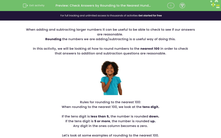When adding and subtracting larger numbers it can be useful to be able to check to see if our answers are reasonable.
Rounding the numbers we are adding/subtracting is a useful way of doing this.
In this activity, we will be looking at how to round numbers to the nearest 100 in order to check that answers to addition and subtraction questions are reasonable.

Rules for rounding to the nearest 100:
When rounding to the nearest 100, we look at the tens digit.
If the tens digit is less than 5, the number is rounded down.
If the tens digit is 5 or more, the number is rounded up.
Any digit in the ones column becomes a zero.
Let's look at some examples of rounding to the nearest 100.
Remember, we look at the tens column.
744 would be rounded down to 700 because there is a 4 in the tens column.
751 would be rounded up to 800 because there is a 5 in the tens column.
8,264 would be rounded up to 8,300 because there is a 6 in the tens column (even though this is a 4-digit number, we are still rounding to the nearest 100)
Now let's use rounding to check if the answer to a subtraction is reasonable:
447 + 673 = 1,120
Now, let's round the numbers:
447 rounds down to 400 (4 in the tens column)
673 rounds up to 700 (7 in the tens column)
400 + 700 = 1,100
1,120 is a reasonable answer to the original question.
Now, it's your turn to have a go at some questions!









